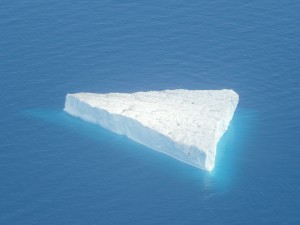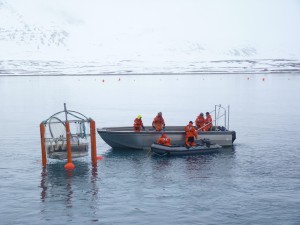Gulf stream heating up
Scientists have observed that the Gulf Steam has been heating up two to three times as fast as the rest of the Atlantic over the last 100 years. Professor Martin Visbeck from the Helmholtz Centre for Ocean Research in Kiel, Germany, says the Gulf Stream, which accounts for the relatively mild climate of north-western Europe, has become around 1.2°C warmer since 1900 compared with a 0.4 degree rise in the Atlantic as a whole. The trend is similar with other important streams off the coasts of Japan, Australia, Brazil and southern Africa.
The scientists say the enhanced warming could reduce the ability of the oceans to absorb carbon dioxide as warmer water absorbs less than cold water. They stress the need for more data and continuous measurement, but Visbeck says the results indicate that climate change is changing global ocean circulation. More in the journal Nature Climate Change.
Sea ice still on the decline
September is the month when the Arctic ice reaches its lowest exten t before the onset of winter. And it probably won’t surprise you to know that the trend has not changed. The minimum ice extent was the second lowest in satellite records after the low of 2007, according to the National Snow and Ice Data Centre, continuing what’s knows as the “decadal trend of rapidly decreasing summer sea ice”. NSIDC says this is a preliminary announcement and the sad 2007 record may yet be beaten, as conditions will still change until early October.
t before the onset of winter. And it probably won’t surprise you to know that the trend has not changed. The minimum ice extent was the second lowest in satellite records after the low of 2007, according to the National Snow and Ice Data Centre, continuing what’s knows as the “decadal trend of rapidly decreasing summer sea ice”. NSIDC says this is a preliminary announcement and the sad 2007 record may yet be beaten, as conditions will still change until early October.
There is a Greenpeace expedition on board the Arctic Sunrise currently up in the Arctic, led by campaigner Frida Bengtsson. Let me quote you her response to the latest figures:
![]() read more
read more
Vulnerable Arctic Treasures

Vulnerable Treasure: Icebergs in Disko Bay, Greenland

Vulnerable Treasure: Chukchi Sea, Alaska
There was plenty of icy news awaiting me when I got back from my spring break. One of the items was entitled “On thin ice: vulnerable Arctic treasures identified”.
![]() read more
read more
On the trail of the truth about Greenland

Running for campus…
Let me recommend you a website and the book it’s based on.I’ve seen it here and it’s very impressive:Arctic Tipping Points
is the title, and it contains some beautiful and in some cases moving images relating to climate change and the Arctic. The editors are Carlos Duarte (quoted in earlier post) and Paul Wassmann (University of Tromsö.

(No tipping point for these swings)
I have been following the presentations dealing with the Greenland ice sheet closely. Sometimes it is a little frustrating when speakers hint at important results of studies which they cannot reveal fully ahead of publication. If you guys are trying to increase the suspense and arouse my interest in reports coming out in the next few months – you have succeeded. On the other hand, it seems a pity, with quite a few journalists sitting in the conference, that we can’t use the opportunity to pass on some interesting results. Unfortunate timing, it seems some of the reports were originally planned to have been ready. But let me sum up what I can here.
Peter Wadhams, Professor of Ocean Physics at the University of Cambridge introduced the strain of the conference dedicated to “ice-ocean-atmosphere interactions in the Arctic”. He refered to very large changes on the Greenland ice sheet, with very large areas of melt occurring in summer and a substantial net flux of fresh water into the sea every year. Now that is one of the key factors in measuring the changes. He told us the amount was almost the same as the total melt from mountain glaciers, suggesting this could be making a comparable contribution to global sea level rise as melt from all the rest of the glaciers in the world put together. He stressed the rate of melt on Greenland is accelerating and scientists just don’t know how the acceleration rate will continue.
Lars Otto Reiersen is the Executive Secretary for AMAP, the Arctic Monitoring and Assessment Programme. He reported on the SWiPA (Project) (Snow, Water, Ice and Permafrost in the Arctic), which is preparing a report to be presented to a meeting of Arctic ministers in May. (sigh!) Suffice it to say, he indicated that when it comes to the mass balance of the Greenland ice sheet, the updated figures will show even higher melt. All will be revealed in a few months, it seems. And it will not be cheery reading.

Late afternoon impression of Tromsö campus while the weather was still beautiful (some like it cold). It is thawing at the moment, but forecast to cool again soon.
Mission accomplished – data worrying. The Arctic ocean acidification project
I have just heard that the experiment I reported on from Svalbard has been concluded. A press release from Greenpeace quotes Professor Ulf Riebesell from the IFM-GEOMAR Kiel Uni ocean acidification project as saying the experiment was a success.

(I took this pic of Prof. Riebesell watching the deployment of the mesocosms last month, see earlier posts).
That doesn’t mean the news is good:
“Not only do we now have the most comprehensive data set ever on the impacts of ocean acidification in Arctic waters, we have also learned from this experiment that ocean acidification in these waters has a definite impact on the base of the food web, which can have implications for the entire ecosystem.” says Prof. Ulf.
“If we keep emitting CO2 at the current rate, marine organisms will experience changes in ocean acidity beyond anything they have experienced in the last 20 million years of their evolutionary history.”
Worrying times indeed.





















Feedback